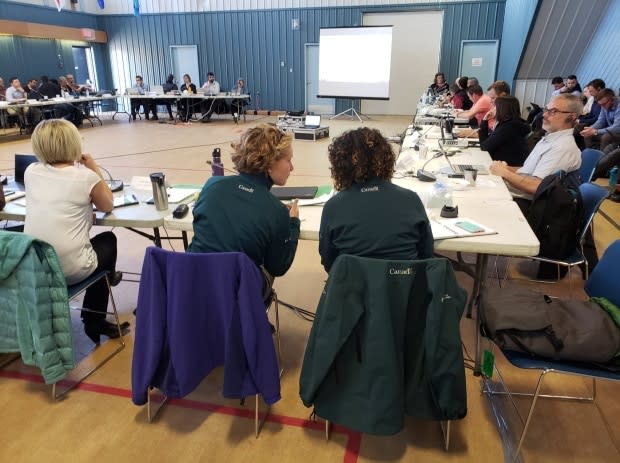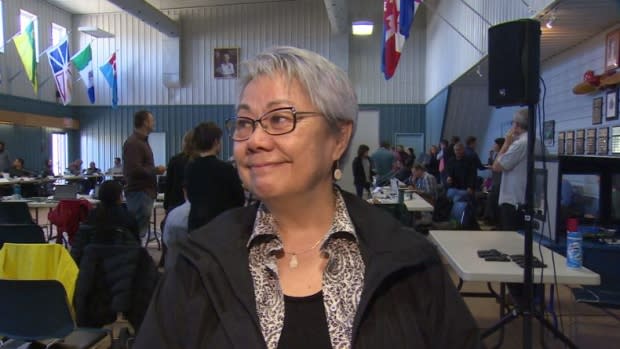North Baffin community loses trust in Baffinland over traditional knowledge use
The communities of Pond Inlet and Igloolik say they're concerned by Baffinland Iron Mines' use of Inuit traditional knowledge — Igloolik's working group even said they'd lost trust in the mining company.
Baffinland's Mary River iron mine is in technical meetings run by the Nunavut Impact Review Board (NIRB) this week in Iqaluit, because the mine wants approval to double the amount of iron ore it can produce.
Pond Inlet raised its initial concerns before the meeting, which wraps up Wednesday, about an article written by a consultant hired by Baffinland, which it felt reduced traditional knowledge or Inuit Qaujimajatuqangit (IQ) to static data.
The article pitched that a technology could help Baffinland determine its impact on caribou, but Pond Inlet said the article presented a view that IQ was only data — for example, a list of caribou migration routes and habitats.
"What should be of concern is a failure to recognize that traditional knowledge is not simply a matter of data, information and statistics. It is ... a complete way of ... bringing meaning and importance to life," Pond Inlet's submission to NIRB said.
Megan Lord-Hoyle, vice-president of sustainable development at Baffinland, said the article was taken down after the complaint.
"I believe that we have a very strong relationship with the north Baffin communities and we want to continue that relationship and trust is a very important part of building that," Lord-Hoyle said.

But the discussion at the technical meetings kept circling back to concerns from communities about how Baffinland used Inuit staff and their traditional knowledge.
Pond Inlet said while Inuit staff are included in the field work portion of environmental monitoring, they feel Inuit are often left out when the data collected is compiled into reports, which leads to publications some Inuit do not find fully representative.
Lord-Hoyle says Baffinland has an "aspirational goal" of 50 per cent Inuit participation in all aspects of the mine, including environmental monitoring, and noted the hamlet's point.
Right now, 367 employees of Baffinland are Inuit. That number would have to increase to around 500 to reach the 50 per cent goal.
New land use study
Based on what it had heard from the communities surrounding the mine, the Qikiqtani Inuit Association is concerned about how and when Baffinland is incorporating Inuit traditional knowledge.
The organization, which represents Inuit on Baffin Island, presented a study it had compiled with residents of Pond Inlet — the nearest community to the iron mine — at the technical review.
The "Tusaqtavut" study functions much like a land use plan, according to the study's manager Eva Aariak, who works with the Qikiqtani Inuit Association (QIA).
"I think this is the area that needs to be understood more because IQ too many times is compartmentalized, it's used as a buzzword but it's who we are. It's our culture," Aariak said.

Aariak says QIA conducted interviews with 35 individuals of all ages to find out how they live their daily life, including where they hunt, fish and just enjoy the outdoors.
The study used Google Earth mapping to mark hunting routes, burial sites and other areas of importance to the community.
"We felt that particularly with the phase two proposals that are out there, the Qikiqtani Inuit Association felt it was important to do it at this time, so the information is available and known," Aariak said.

What's in phase two
Versions of phase two of the mine have been under regulatory review since 2014, but the final public hearings on a plan to double the amount of iron ore mined and shipped out of Mary River are scheduled for Sept. 16 - Sept. 20 in Pond Inlet.
Baffinland currently has permission to ship out six million tonnes of iron ore per year through Milne Inlet, but it wants to increase that to 12 million tonnes.
"Economics of the project are not such that it can be sustained [at current production rates]," said Lord-Hoyle.
Lord-Hoyle says expansion was always part of the mine's plan.
The company is currently proposing to build a 110-kilometre-long railway to Milne Inlet from the mine site and increase the size and number of ore transport ships during the open water season in order to reach the new output.
This version of phase two underwent a technical review in April, but Baffinland was unable to provide the data interested parties were looking for to move to the next phase of the approval process.
As a result, the Nunavut Impact Review Board (NIRB), which runs the environmental approval process, scheduled this second round of technical hearings.
Baffinland provided more documentation this round, but several questions have still been flagged for needing follow-up, including QIA's study.
The mine company and the Inuit organization have plans to meet "offline" and bring their resolutions back to the public hearings.
QIA acknowledges Baffinland has done some traditional knowledge studies, but it would like to see, Baffinland continue to update its bank of Inuit traditional knowledge and find more ways to bring cultural ideas into the workplace.


